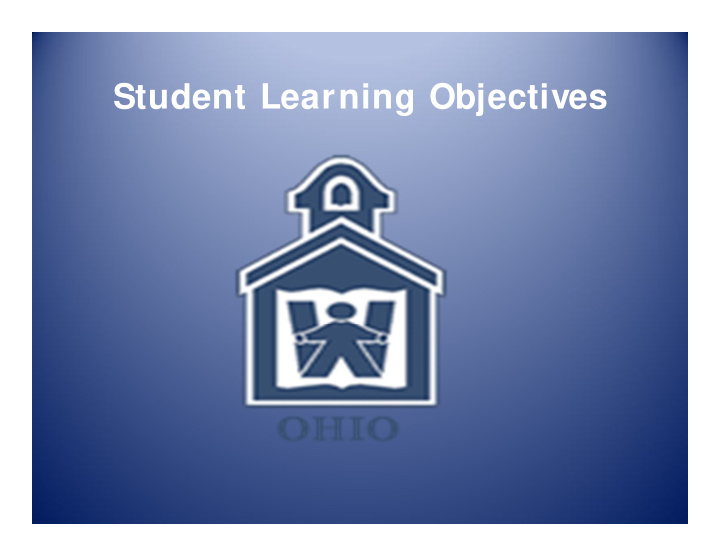



Student Learning Objectives
Definition of Student Growth • For the purpose of use in Ohio’s evaluation systems, student growth is defined as the change in student achievement for an individual student between two or more points in time .
What are Student Learning Objectives? An SLO is: • A goal that demonstrates a teacher’s impact on student learning within a given interval of instruction. • A measurable, long-term academic target written by an individual teacher or a teacher team.
Why SLOs? • There are many benefits to using SLOs as a measure of student growth: – Reinforce best teaching practice – SLOs are adaptable – SLOs acknowledge the value of teacher knowledge and skill – Potential for collaboration
Worthington Specific SLO’s • In Worthington ALL teachers will create a single SLO focusing on vocabulary acquisition of Academic and Content Vocabulary (Tier II & III). This SLO covers a single preparation or content area for the majority of the students the teacher teaches.
Specific Teacher Examples • High School Teacher A teaches three classes of Chemistry one class of AP Chemistry and one class of Biology. The SLO would be written for the three classes of Chemistry. • Sixth Grade Teacher B teaches Math for three classes and one class of Language Arts. The SLO would be written for the three classes of Math. • First Grade Teacher C teaches all subjects. The First Grade Team at teacher C’s school will determine the subject area they will assess for their SLO. • Elementary Music Teacher D will choose one grade level to write his/ her SLO for. • Intervention Specialist E will include all students on his/ her caseload on his/ her SLO. These students will also be included in the classroom teachers SLO if they are mainstreamed or Co-Taught. • Teacher F teaches five classes that only meet for one semester. The SLO will cover first semester only for the class with the majority of students the teacher teaches.
Why Vocabulary for Worthington? • Vocabulary acquisition of Academic and Content vocabulary is a high yield instructional strategy for all students and has it’s highest yield for our targeted student populations. • Vocabulary acquisitions cuts across all content areas and all grade levels. • Vocabulary acquisition is measurable.
SLO Components 1. Baseline and Trend Data – Summarizes student information (test score from previous years, results of pre-assessments), – Identifies student strengths and weaknesses, and – Reviews trend data to inform the objective and establish the amount of growth that should take place. 2. Student Population. Includes the following: – Students – Course – Grade level – Number of students included in the objective.
SLO Components 3 . Interval – The duration of the SLO including start and end dates 4 . Standards and Content. – SLO should cover the content, skills, and specific standards to which the SLO is aligned. – SLOs should be broad enough to represent the most important learning or overarching skills, but narrow enough to be measured. 5 . Assessment(s). – Assessments that will be used to measure student growth for the objective. – Assessment(s) should be reviewed by content experts to effectively measure course content and should have sufficient “stretch” so that all students may demonstrate learning. – If supplemental assessments are needed to cover all ability levels in the course, this section should provide a plan for combining multiple assessments.
SLO Components 6. Growth Target(s). – The target for student growth should reflect high expectations for student achievement that are developmentally appropriate. – The targets should be rigorous yet attainable. 7. Rationale for Growth Target(s). – High quality SLOs include strong justifications for why the goal is important and achievable for this group of students. – Rationales should draw upon assessment, baseline and trend data, student outcomes, and curriculum standards and should be aligned to broader school and district goals.
SLO Rubric
Growth Targets • Should be informed by baseline or, in some cases, trend data. • Should include specific indicators of growth that demonstrate an increase in learning between two points in time. • Should be tiered whenever possible and appropriate. • Should be set so that all students can demonstrate developmentally appropriate growth.
Growth Targets • All students must be expected to demonstrate growth. • The expectations captured in growth targets should be rigorous yet attainable. • Growth targets should articulate a specific minimum expected performance.
Example Growth Targets
Scoring Example
What Comprises an SLO Score? An SLO final score represents the percentage of students that met their growth targets. The percentage of students that met the growth target then falls within a range that corresponds to one of five descriptive and numerical ratings.
SLO Evaluation Cycle SLO Development Process Discussion of the Summative Rating and SLO Approval Impact on Practice Final Review of SLO M idcourse Attainment and Check-In Scoring
Meeting with the Evaluator • Determine overall attainment of SLOs • Discuss factors that may have impacted SLO attainment • Plan to use the results of the SLOs to inform professional development and goals for next year • Final meeting with Evaluator will be aligned with final meeting from Teacher Observations and occur before May 1st • All principals must submit teacher ratings to eTPES by no later than May 10th
Recommend
More recommend